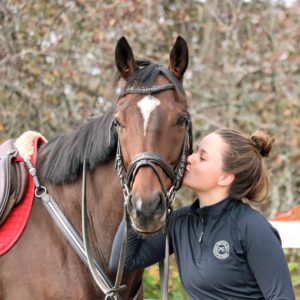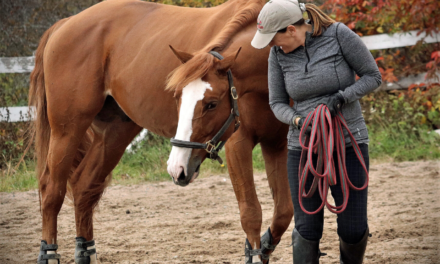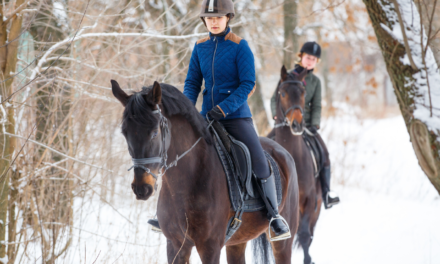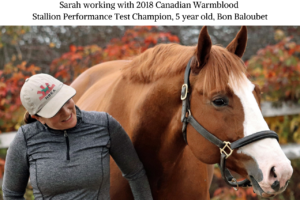We may earn money or products from the companies mentioned in this post. For more information please check out our disclosure page
TRAINING ISSUES WITH TINK
Learn how to keep your horse from falling in on the lunge line by following Tink's story below and following the same steps.
BACKGROUND
Tink was a 5-year-old OTTB gelding I got straight of the track August 2018. He is a stunning horse and an incredible mover. When we first got him he had already had some downtime at his trainers.
We gave him a couple of weeks and worked with him on the ground a little. He was super quiet to work with, trailered like a dream and was easy to manage in every way.

.
Having established that he was easy to handle and responded well to groundwork, we lunged him and one of my working students at the time rode him and although he didn’t know too much with regards to the type of riding we wanted from him, he was pretty awesome.
As he was an OTTB its important to follow certain steps for their new life. His feet were pretty bad so we took off his shoes and gave him 3 months downtime to harden up his feet.
That brings us to now and Tink getting back to some serious training.
The purpose of this blog is to go over some issues we had during his training and to discuss how we got over them. By using the same steps you can stop your horse from falling in.
LUNGING ISSUE
The Purpose
To start getting Tink back into fitness and working together I put him on the lunge line with bridle, long reins and surcingle. The purpose was to do some gentle walk and trot work with him responding to voice commands
The Problem
This can be a common problem with greener horses. Tink was rushing, not listening and falling in on the circle. I allowed him to rush and have some fun rather than fight with him, sending him out on the lunge line as much as he would listen.
The Remedy
The next lunging work session before getting him ready to lunge I made a circle of poles going from the inside to outside of a 15m diameter circle leaving plenty of space for me to stand in the center.
The Equipment
To get the results you need lunging you NEED to use the proper equipment. You will need the following:
- ” target=”_blank” rel=”noopener noreferrer”>Lunge cavesson or bridle with a snaffle bit (remove the reins if you are using a bridle)
- Weaver Leather Neoprene Surcingle
” target=”_blank” rel=”noopener noreferrer”>Surcingle (with saddle pad underneath for protection)
- Perri's Beta Donut Side Reins, Black, 35-42-Inch
“>Side reins
- Weaver Leather Lunge Whip with Rubber Handle
” target=”_blank” rel=”noopener noreferrer”>Lunge whip
- Weaver Leather Flat Cotton Lunge Line, Turquoise
” target=”_blank” rel=”noopener noreferrer”>Lunge line
- Tough 1 Polo Wraps, Black
” target=”_blank” rel=”noopener noreferrer”>Polos for leg protection
- ” target=”_blank” rel=”noopener noreferrer”>Bell boots to stop your horse from damaging his heel bulb or pulling shoes
- Gloves
- Poles
The Instructions
I put him on the outside of the circle and walked back into the center. ( I am a firm believer that when lunging you send the horse out and away from you, but in this exercise it isn’t viable)
As expected he got excited and forward and tried to cut in. I let him make this mistake and just followed him around the circle encouraging him to stay out using a long lunge whip and pointed it at his shoulder telling him “out”.
The purpose of words is to condition them to eventually understand that saying “out” means he stays out! In addition to asking him to stay out, the poles made it difficult for him to fall in.
His job at this point is to learn that falling in and coming over the poles was much harder than staying out.
Your job is to stay patient, be consistent with instruction, and wait for your horse to make the right decision to stay outside of the ground rails on the ground.
Once he has done that we need to teach him to trot at a rhythm and start to properly use himself. This may take more than one lunge session but we can start now.
As your horse is moving around the correct circle make sure you are connected through the lunge line and then give small squeezes with your hand periodically, saying “whoa” or “easy” in a relaxed long tone.
Repeat until he listens. Again this may take time and will certainly take more than one attempt to get him consistent in understanding but you should have some result from this first session before you reward and call it a day.
Remember – ASK FOR LITTLE AND REWARD LOTS!
This is your language together and how your horse will know they are doing the right thing
admin
Latest posts by admin (see all)
- A Horse For All Reasons – Guest Blog by Lucy from Horse Factbook - April 8, 2020
- How To Deal With A Spooky Horse Trail Riding - March 31, 2020
- Our Top 20 Amazon Equestrian Products - January 30, 2020










